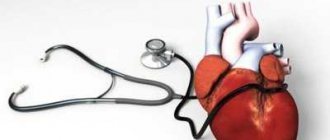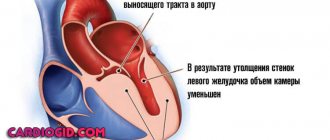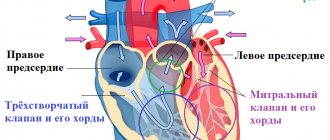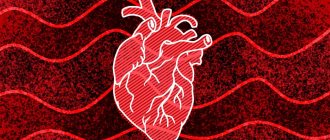The heart is the most important human organ, providing oxygen and nutrients to the entire body. This means that it is the heart that is “responsible” for the normal functioning of the entire body.
Recently, more and more children are born with various pathologies. This may be due to poor ecology, bad habits of parents, and unscrupulous performance by doctors of their professional duties. Today, problems with the heart and blood vessels are the most common among childhood ailments.
Every newborn, already in the first month after birth, undergoes diagnostics to identify various diseases. Parents often hear that their baby has a murmur in their heart.
However, this does not mean that you need to sound the alarm right away. It is very important to undergo a full examination to determine why murmurs appeared in the baby’s heart. Then, if necessary, undergo a course of treatment.
Causes contributing to the occurrence of heart murmurs
Often, the presence of a murmur in a baby’s heart is associated with the fact that the circulatory system is transitioning from functioning inside the mother’s womb to its normal extrauterine activity. Due to the characteristics of the fetal cardiovascular system, the blood that flows in its arteries is always mixed. This is due to the following anatomical formations:
- Oval window;
- Arterial or Batalov duct;
- The ductus venosus, also called the ductus of Arantius.
Their functioning continues in the newborn baby. However, after a certain time, they become overgrown or closed.
Oval window
It is located in the interatrial septum and, as a rule, it should close in the first month of the baby’s life due to the fact that pressure increases in the left atrium. There is no need to be upset if it does not close in the first month. Closing the window can also occur after two years. An important aspect is that an unclosed oval window in very rare cases causes hemodynamic disturbances, so its presence does not have a negative impact on the development of the baby.
Ductus arteriosus
Serves to connect the pulmonary trunk with the aorta. Its functioning usually stops between two weeks and two months of the baby's life. If after this period of time the ECG results show that the duct is still present, we can say with absolute certainty that the baby has a congenital heart defect.
Ductus venosus
The portal and inferior vena cava are connected by the ductus venosus. Its disappearance occurs almost immediately after the baby is born. The ductus venosus is almost never preserved during blood circulation outside the mother's womb. This means that because of it, a newborn cannot develop congenital heart defects.
Causes of occurrence in children
The most common sources of heart murmurs in a child are associated with impaired blood flow and the occurrence of turbulence in the supravalvular aorta, pulmonary trunk or organ cavities. The causes of this hemodynamic disorder are a defect in the valve apparatus or septum, vascular aneurysm, decreased blood viscosity due to anemia, and the following cases:
- if the child is premature, the source of the noise is an insufficiently formed heart, incomplete closure of the aortic duct after birth;
- when a soft systolic murmur is heard in the first three days after birth, this indicates anatomical obstruction of the ventricular outlets, which requires daily monitoring over time;
- mixed systolic-diastolic murmur often occurs when the aortic duct is incompletely closed, which closes upon completion of the transition from fetal blood flow after birth;
- the most common cause of heart murmur in a newborn is a patent aortic duct (the turbulence is quiet, blowing, more audible between the second and first heart sounds);
- listening to murmurs in a child during systole is convenient on the third or fourth day in case of cardiomyopathy and impaired transitional circulation, the formation of a pathological shunt from the right side of the heart to the left and vice versa;
- the main sign of pathology of the cardiovascular system and congenital valve defects is hemodynamic disturbances, cyanosis (blue discoloration of the skin), arterial hypoxemia and decreased saturation (oxygen saturation in the blood) less than 75%;
- in older children, the source of noise is a past illness, cold, sore throat or acute respiratory viral infection. As a result, the inflammatory process and bacterial culture provoke damage to the heart valves, endocarditis (inflammation of the endocardium);
- If a child is over five years old and a murmur is heard during auscultation, the cause is often an anomaly of the left ventricle, an accessory chord, which can only be detected by ultrasound of the heart. When there is no hemodynamic disturbance, treatment is not required.
Unlike pathological noise, functional noise is always heard during systole, it is less intense. In newborns, auscultation reveals a greater spread of vortices beyond the boundaries of the heart. If the child does not have a rapid heartbeat, cyanosis or signs of heart failure, then such a noise is not dangerous, but requires observation. It is enough to have an assessment of functional noise over time, recording cardiogram data, and ultrasound of the heart.
Abnormal acoustic noises can appear normally or only when the functioning of any organ is disrupted. Their occurrence can be life-threatening if not detected in time. There are several types of causes of heart murmurs in newborns and older children:
- physiological;
- pathological.
The former do not exist throughout life, and under certain conditions they disappear on their own. Noises that appear in infants under the influence of various diseases can only be eliminated with the help of treatment.
Normally, at a certain stage of life, sound phenomena always appear in a child. Both parents and the attending physician should be aware of this feature so as not to miss the problem. Almost half of the examined children exhibit these phenomena.
- A newborn baby immediately after birth adapts to dramatically changed conditions. His body begins to completely independently provide itself with the necessary beneficial compounds and oxygen. Noises appear especially often in infants of mothers who have had a caesarean section.
- At the age of 4 to 7 years, increased growth begins, and for this reason, cardiac activity becomes most active.
- The last period during which extraneous sounds occur is associated with adolescence. At this stage, this is the norm for a child. Additionally, the influence of excessive physical activity and the work of the vagus nerve are characteristic.
Functional changes are considered a minor problem that occurs in the baby. They reflect the work of the myocardium in systole and do not require medical assistance. During the process of adaptation of the body, they disappear without leaving any consequences.
Minor anomalies in the structure of the heart have a negative effect on the functioning of cardiomyocytes. Congenital changes do not pose a threat to the baby. Features of the anatomy of the respiratory system create conditions that interfere with the normal functioning of the organ. Due to slight compression of the cavities, the process of moving blood into the vessels is somewhat disrupted.
Metabolic changes are accompanied by anemia. They manifest themselves by accelerating blood flow. Due to this feature, the body strives to enrich tissues with oxygen and nutritional compounds. When the cardiovascular system is activated, vortices are formed in the cavities of the muscle pump. This symptom in places of turbulence causes a malfunction of the valve apparatus, which is manifested by their inadequate closure.
Pathological noises
In small or adult children, in rare cases, foreign acoustic phenomena are detected in the organ. A more thorough diagnosis allows you to understand the problem. Examination methods make it easier to find the cause of heart murmurs in a child, which most often have a pathological origin.
Diseases and conditions that provoke extraneous sounds in the cavities of the heart include the following:
- cardiomyopathy;
- pericarditis of rheumatic origin;
- the presence of a heart defect;
- rickets;
- pathology of the thyroid gland;
- inflammation of the endocardium.
The cause of noise, which is of organic origin, is most often associated with rheumatism. The disease affects the valve apparatus with its own cells. They become aggressive, and in the event of an immune disorder, defense mechanisms are directed against the tissues of their own body.
Normally, the left ventricle has a chord. It is a tissue whose task is to connect the opposite walls of the cavity. In rare cases, there is an increase in the number of such formations. They are not life-threatening, but in some children they cause abnormal noises.
Heart defects are always accompanied by extraneous noise. One of the most common is the open duct between the ventricles. The disease can be detected before the end of the baby’s second month of life. An oval window in the septum may not manifest itself for a long time. The main features are as follows:
- loss of consciousness;
- the infant does not eat well;
- weakness that does not go away with rest;
- excessive sweating.
https://www.youtube.com/watch?v=71u-_HiUKNE
Blood tests and instrumental studies can confirm the diagnosis.
False chords
Very often, the reasons why heart murmurs occur in a newborn are associated with the abnormal location of the chords in the left ventricle of the heart. They connect the opposite walls of the ventricle. Another name for them is false chords. The number of false chords and their location affects the intensity of the child’s heart murmur. This anomaly is relatively harmless, since it does not cause circulatory problems in the heart. However, some evidence suggests that false chords may contribute to abnormal heart rhythms.
And this is not the entire list of reasons. There are a lot of them, we only talked about the most common ones.
Features of treatment and observation
Regardless of the origin, location and intensity of the disease, the child must first undergo a thorough examination. This is necessary in order to make the most accurate diagnosis and determine the cause of its development.
If the child's heart murmur is of minor complexity, the baby does not require hospital treatment. An echocardiogram and consultation with a cardiologist approximately once a year is sufficient. As the practice of many specialists shows, minor noises cannot provoke the development of a serious disease or complication. This means that children can play sports, dance and lead an active lifestyle.
In the event that a murmur in a baby’s heart indicates the development of a defect that can be corrected surgically, such patients are monitored in a hospital. And after the operation, they are monitored throughout life by a cardiologist.
A fairly large group is occupied by patients whose heart murmurs indicate the presence of a degree of pathology that cannot be corrected surgically.
Such children require constant drug therapy and supervision by specialists.
In any case, the presence of a heart murmur in newborns means that it is necessary to immediately consult a specialist. The future life of the child depends on this.
Types of noise
Based on the nature of origin, heart murmurs in infants are differentiated into:
- Systolic murmur occurs when the heart contracts and pushes blood into large vessels. This noise usually does not pose a danger to the child;
- Diastolic murmurs that occur when the heart is in a relaxed state and is filling with blood.
Depending on what causes heart murmurs in a child, they are divided into the following types:
- Organic , which appear due to the fact that the pericardium, vessels and valves have some defects;
- Functional - have a temporary effect and are associated with the growth characteristics of the child’s heart and blood vessels.
Description of the syndrome, how to detect it?
What does a heart murmur mean?
- The heart consists of four chambers: 2 atria and 2 ventricles. Between them there are valves, they continuously open and close. They take turns filling with blood in the diastole phase. And they empty (contract) in the systole phase. Cardiac systole - what is it?
- We call these tones knock , but it has a medical term - tone. In between there are pauses - called lulls. It is in them that excess noise can be heard. There may also be harmless ones, completely safe for health and life.
- But there are often congenital anatomical abnormalities in the structure that lead to disability, and, if adults do not act, to irreversible consequences and even death of the child. The need for surgical intervention leaves no time to think; you need to act.
- The noise can be detected in the maternity hospital , in the first days of life. If the baby has minor functional noises, this is considered normal.
Next, you need to carefully observe at home so that the baby does not develop signs characteristic of non-pathological noises:
- difficulty breathing, shortness of breath;
- blue discoloration of the skin;
- loss of appetite, lethargy;
- weak palpation or absence of pulse.
In infants, congenital noises may not appear immediately, but over the course of two or more months. This may indicate insufficient development, or a defect (during pregnancy).
Such children should be kept under constant control; if there is a threat to life, an operation is performed.
What is functional noise?
Another name for such noises is innocent. The cause of their occurrence is not anatomical problems, and they do not threaten the health of the baby. Functional noises in newborns are an age-related feature, since they disappear on their own as the child grows older.
Most noise of this type is characterized by a low degree of intensity. It may decrease or increase during different periods of the baby’s growth.
As a rule, functional murmurs in the heart of a newborn do not require treatment; it is only necessary to carry out examinations from time to time and seek advice from a pediatric cardiologist.
First of all, you should understand the nature of the origin of the noise. Functional noise can be caused by the following reasons:
- Venous blood enters the heart. In this case, the sound resembles a gurgling or buzzing sound. Its duration and timbre vary depending on the child’s posture; in a supine position, such noises are not heard;
- Acceleration of blood flow in the lung tissue. It contributes to noise associated with physical activity and intoxication;
- Noises in a child’s heart are heard if the baby has a thin build;
- Heart chambers and valves grow at different rates;
- False chords and other minor cardiac anomalies;
- Metabolic disorders in the heart muscle caused by excessive exercise or lack of nutrition. As a result, the baby may develop cardiodystrophy or cardiopathy. However, both of these problems are treated, and with it the noise goes away;
- Presence of anemia. Lack of hemoglobin in the blood is often the cause of anemic murmur in a child’s heart.
Causes of murmurs in infants
In infants, the appearance of heart murmurs is most often due to the fact that the oval window has not closed. It should be overgrown when the baby reaches one year of age. Even if the window did not close until the age of 3, this does not indicate a congenital defect, but the individual characteristics of the baby.
During the first – second months of life, murmurs in the baby’s heart appear due to a functioning ductus arteriosus. Ideally, its closure occurs already in the first days of life. In babies born prematurely or as a result of Caesarean section, the ductus arteriosus closes in the 2nd month after birth.
Load without overloading
If a child has a serious heart pathology, of course, it is necessary to strictly follow all the recommendations of a cardiologist and, possibly, a cardiac surgeon. What if the noise is “innocent”? Then protect the child from any stress, exempt him from physical education lessons and help with housework? Protect from any unrest?
It is best to maintain reasonable limits. From the necessary: daily routine, work and rest, as well as nutrition. All this, by the way, is good for any child, not just the “noisy” one. As for stress (both physical and psycho-emotional), the golden mean is important here: professional sports and many different after-school clubs are really not the best idea. But it’s also not worth turning your child into a crystal vase, since the child must train his heart, and for this he needs to walk a lot, breathe fresh air and, of course, exercise in moderation. Therefore, no exemptions from physical education! On the contrary, children with a heart murmur should spend a lot of time moving in order for their chest to develop properly, as a result of which the murmur will disappear on its own. Swimming, skiing, skating, cycling, and dancing are recommended. But activities associated with the jerky nature of movements (jumping, weightlifting, wrestling...), on the contrary, are harmful.
In addition, a child with a heart murmur should not have foci of chronic infection, because any inflammatory process in the body (even caries) can aggravate the pathology. To nourish the heart muscle, you need food rich in complete protein (meat, fish, cottage cheese, eggs). Fresh fruits and vegetables are healthy, as well as dried fruits rich in potassium and magnesium, bananas...
Diagnostic methods
For children with heart murmurs, the following types of examination may be prescribed to diagnose the cause already in the first month after birth.
Electrocardiogram
It helps detect problems with the heart.
Echocardioscopy
Using ultrasound, the doctor examines large vessels, heart cavities and valves. As a result of this examination, he reveals the presence of pathologies in the form of growths, narrowings or expansions, doublings, etc.
X-ray
X-ray allows the doctor to see the boundaries of the heart and see the condition of the child’s lungs.
Diagnostics
During regular examinations of newborn children, one of the mandatory methods used by specialists is auscultation. Its essence is to listen to the child’s chest using a phonendoscope. Thanks to this, it is possible to identify noises at an early age, as well as find out the approximate cause of the pathology.
In second place in the effectiveness of studying the condition of the heart is echocardiography, which is carried out as a result of the use of ultrasound. This method is simple, safe and effective. The use of echocardiography makes it possible to determine the following indicators:
- speed of blood flow;
- pressure level in the cavities of the heart;
- direction of blood flow.
Good results can be achieved using computed tomography or magnetic resonance imaging. These techniques are especially valuable if there is a need to identify the condition of several organs or systems of the baby’s body.
The difficulty lies in the fact that these examination methods require almost absolute immobility from the small patient. But it is not possible to achieve this from a child. Therefore, during these examinations, children are given anesthesia.
What does Dr. Komarovsky think about this?
A well-known pediatrician also supports the opinion that it is necessary to carry out qualified diagnostics to accurately determine the causes of the formation of murmurs in the heart of a small patient.
Dr. Komarovsky focuses on the following aspect: heart murmurs, accompanied by the baby’s well-being and the absence of any complaints, should not cause concern to parents.
Restless condition of the baby, the appearance of shortness of breath, a slight increase in temperature, bluish lips, poor weight gain and developmental delay - this is a reason to immediately contact a pediatrician.
Diagnostics
During regular examinations of newborn children, one of the mandatory methods used by specialists is auscultation. Its essence is to listen to the child’s chest using a phonendoscope. Thanks to this, it is possible to identify noises at an early age, as well as find out the approximate cause of the pathology.
In second place in the effectiveness of studying the condition of the heart is echocardiography, which is carried out as a result of the use of ultrasound. This method is simple, safe and effective. The use of echocardiography makes it possible to determine the following indicators:
- speed of blood flow;
- pressure level in the cavities of the heart;
- direction of blood flow.
Good results can be achieved using computed tomography or magnetic resonance imaging. These techniques are especially valuable if there is a need to identify the condition of several organs or systems of the baby’s body.
The difficulty lies in the fact that these examination methods require almost absolute immobility from the small patient. But it is not possible to achieve this from a child. Therefore, during these examinations, children are given anesthesia.
Treatment options
The doctor’s choice of treatment method for a baby’s heart murmur is largely influenced by what caused the problem. If during the examination no organic lesions of the heart were detected and there are no complaints, there is no need for treatment. If the appearance of murmurs is due to heart pathologies, treatment is chosen based on the severity of the disease.
To cure compensated cases, drug therapy is usually used, which is aimed at improving the nutrition of the myocardium and the metabolic processes of the heart muscle. The baby is prescribed to take vitamin complexes, glycosides and other similar medications. If necessary, the child is also prescribed diuretics or medications containing hormones.
If the appearance of heart murmurs is associated with the presence of serious defects, then surgical treatment is used. Depending on what pathology is detected, valve replacement, stent installation, vessel clamping, etc. can be performed. After the operation, the baby is prescribed blood thinning medications, and is also given treatment to speed up the rehabilitation period and avoid possible complications.
Prognosis for the disease
The main consequences for the child are:
- malformations in the development of the pulmonary artery;
- underdevelopment of the pulmonary valve;
- anomalies in the position of the main vessels;
- unclosed gaps in the partitions.
To eliminate these complications, operations are performed, as a result of which the child’s health is restored, he lives a full, long life. Untimely correction leads to the development of secondary immunodeficiency and significantly reduces life expectancy. Registration with a cardiologist, periodic examinations and examinations are required so as not to miss the time when the child will need medication correction.
Cardiologists make cautious forecasts for life and health. Many defects require long-term multi-stage treatment, including physical therapy. Such children are immediately assigned a disability group; their quality of life is often limited.
As we have already understood, the prognosis for the life and health of a small patient depends on many factors, including logistical ones. A number of defects are completely corrected after surgical treatment, and the child is cured.
Some defects are subject to multi-stage correction, including several heart surgeries and constant medication. Such children receive a disability group and most often have a severely limited quality of life.
Heart defects associated with severe genetic syndromes and combined with other developmental defects: anomalies of the limbs, brain, and genitourinary system are usually incurable. Most of these patients die in the first months of life or remain deeply disabled. Therefore, genetic counseling of a pregnant woman and high-quality ultrasound screening of the fetus, starting from the earliest stages of pregnancy, play a huge role in the prevention of such defects. In the CIS countries, genetic screening of pregnant women reveals about 76% of pathologies, which is a very good indicator.
Who is at risk?
Congenital cardiac or vascular abnormalities occur for a variety of reasons. This may be due to poor heredity, pathologies during pregnancy, taking medications and vitamins while expecting a child, infertility treatment, etc.
Bad habits before and during pregnancy and unfavorable environmental conditions in the place where the expectant mother lives can also provoke heart pathologies. The age of the woman giving birth, exceeding 35 years, also increases the risk of such diseases. The risk group also includes babies who were born by Caesarean section.










